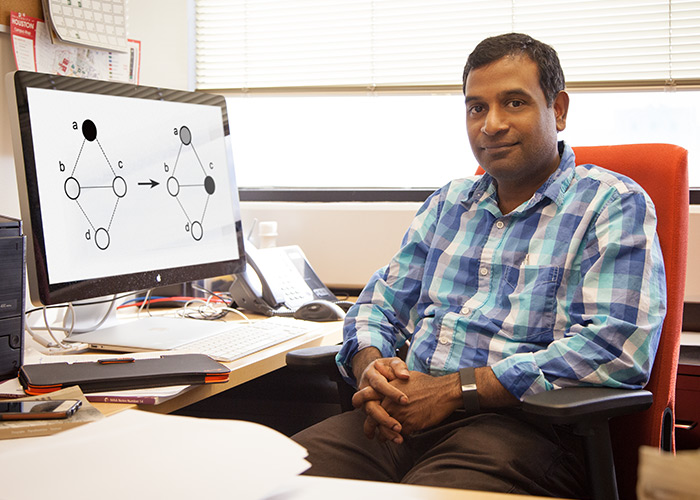UH Computer Scientist Works to Provide Real-Time Capability for Epidemiology
Whenever a disease starts spreading, health officials need forecasts they can use in real-time. These forecasts need to keep up with changing conditions, such as vaccination drives or school closings, all while providing the most effective methods of limiting new infections.
Most Accurate Methods for Predicting Epidemics Are Time-Consuming
“How do infections spread, and even more importantly, how do we predict the most effective intervention methods for limiting the spread?” said Gopal Pandurangan, associate professor of computer science at the University of Houston’s College of Natural Sciences and Mathematics. “The most accurate methods we have for answering these questions are computationally intensive, requiring a lot of time.”
 Gopal Pandurangan, associate professor of computer science, works on algorithms that
increase the speed of forecasting the spread of disease.Methods for calculating the spread of disease can be used to forecast everything from
the flu to emerging diseases such as Ebola or Zika. Although the exact method of transmission
varies between diseases, the commonality is that they can all be modeled through the
use of social contact networks. Algorithms designed for use on large-scale networks
allow for the computation of metrics associated with the spread of disease, such as
the number of new infections and rate of spreading.
Gopal Pandurangan, associate professor of computer science, works on algorithms that
increase the speed of forecasting the spread of disease.Methods for calculating the spread of disease can be used to forecast everything from
the flu to emerging diseases such as Ebola or Zika. Although the exact method of transmission
varies between diseases, the commonality is that they can all be modeled through the
use of social contact networks. Algorithms designed for use on large-scale networks
allow for the computation of metrics associated with the spread of disease, such as
the number of new infections and rate of spreading.
Pandurangan was awarded a four-year, $550,000 BIGDATA grant from the National Science Foundation. This grant, part of a $1.8 million collaborative project, will focus on the design and analysis of efficient and scalable distributed algorithms for network problems with an emphasis on improving the speed at which computational epidemiologists can simulate the spread of disease.
Pandurangan’s research group, along with collaborators at Indiana University, will focus on developing provably efficient algorithms for large-scale network problems. Meanwhile, collaborators at Virginia Tech will focus on applying these algorithms to computational epidemiology.
Social Contact Networks Enable Epidemiologists to Predict Spread of Disease
Simulating the spread of disease means constructing a social contact network for an area, which provides estimates for how people move and interact. Every time a person comes into contact with another person, there is the risk of spreading disease. This network of social contacts is what enables epidemiologists to forecast how a disease might spread.
The number and duration of social contacts can vary based on a person’s job, use of public transport or whether they have children enrolled in school. All of these factors alter how and when disease will spread.
“To simulate the spread of a disease, you have to run each calculation multiple times, taking into account the average probability of an individual getting infected. This can be time-consuming, with tens of millions of calculations,” Pandurangan said. “For this project, my research group is focusing on using distributed computing to study large-scale network data.”
Distributed Computing Enables Calculation of Larger Problems
Distributed computing is when different entities, such as individual computers, interact with each other. It can be used to speed up calculations by breaking up a larger problem into smaller portions, parceling these out among many different processors. Distributed computing also means that larger problems can be solved.
Currently, one of the limiting factors in speed is the time it takes for different computers to communicate with each other.
“Communication is costly in terms of speed,” Pandurangan said. “We want to optimize this step, so that we can get to a point where we can make these calculations in real-time.”
Pandurangan’s group, along with the group at Indiana University, will be working on minimizing the amount of computer communication needed for running calculations. Meanwhile, the Virginia Tech group will focus on integrating this into their epidemiology methods.
“The theory we are developing will have much larger applications to fundamental problems in computer science,” Pandurangan said. “The fact that this has applications to epidemiology, including the Zika virus, is very exciting.”
- Rachel Fairbank, College of Natural Sciences and Mathematics